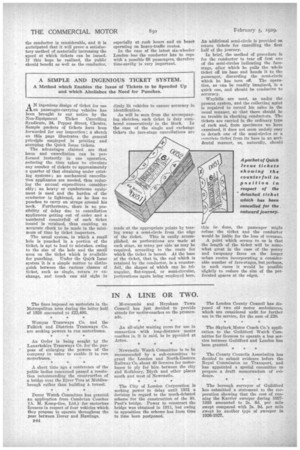A ' ingenious design of ticket for use on passenger-carrying vehicles
Page 28

If you've noticed an error in this article please click here to report it so we can fix it.
has been brought to our notice by the Non-Equipment Ticket Cancelling Syndicate, 24, Pepper Street, 'Chester. Sample packets of tiekets have been forwarded for our inspection; a sketch on this page illustrates the general prieciple employed in printing and stomping the Quick Issue tickets.
The advantages claimed are that Issue and cancellation can be performed instantly in one operation, reducing the time taken to circulate any number of tickets to approximately a quarter of that obtaining under existing systems; no mechanical cancellation appliances are needed, thus reducing the annual expenditure considerably; no heavy or cumbersome equipment is used and the burden of the cenductor is lightened, as he has no punches to carry on straps around his neck. Furthermore, thea-e is no possibility of delay due to cancellation . appliances getting out of order and a numbered counterfoil of each ticket.' issued is retained, thus enabling an accurate check to be made in the minimum of time by ticket inspectors.
The usual system, in which a small hole is punched in a portion of the ticket, is apt to lead to mistakes, owing to the size of the hole and the small area on the ticket which is available for punching. Under the Quick Issue system it is a simple matter to distinguish between the various classes of ticket, such as single, return or exchange, and touch can aid sight in
dimly lit vehicles to ensure accuracy in identification.
As will be seen from the accompanying sketches, each ticket is duly num bered consecutively in the block. In the case of the single and exchange tickets the fare-stage cancellations are made at the appropriate points by tearleg away a semi-circle from the edge
of the ticket. This is easily accomplished, as perforations are made at each stage, as many per side as may be required, according to the route for which the ticket is issued. At the base of the ticket, that is, the end which is retained by the conductor, is a counterfoil, the shapes of which can be triangular, fiat-topped, or semi-circular, perforations again being employed here.
An additional semi-circle is provided on return tickets for cancelling the first half of the journey. In brief, the method of procedure is for the conductor to tear off first one of the semi-circles indicating the farestage, after which he pulls the whole ticket off lie base and hands it to the passenger, discarding the semi-circle which he has torn off. The operation, as can be readily imagined, is a quick one, and should be conducive to accnracy.
Waybills are used, as under the present system, and the collecting agent is required to record his sales in the usual manner, so that there should be no trouble in checkieg conductors. The tickets are carried in the ordinary type of reek and, from specimens we have examined, it does net seem unduly easy to detach one of the semi-circles or a corn elate ticket from its base in an accidental manner, as, naturally, should this be done, the passenger might refuse the ticket and the conductor would be liable for the loss of revenue.
A point which occurs to us is that the length of the ticket will be somewhat great in the case of the penny and twopenny fares on the longer urban routes incorporating a considerable number of fare-stages, but perhaps, in such cases it would be possible slightly to reduce the size of the perforated spaces at the edgea.


































